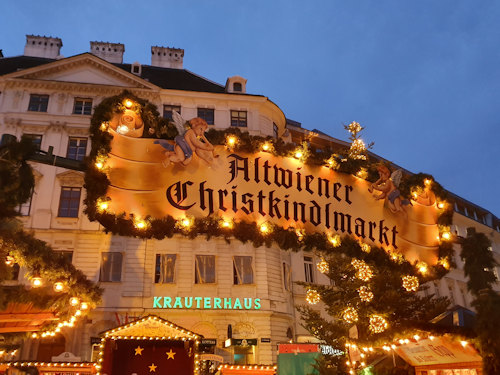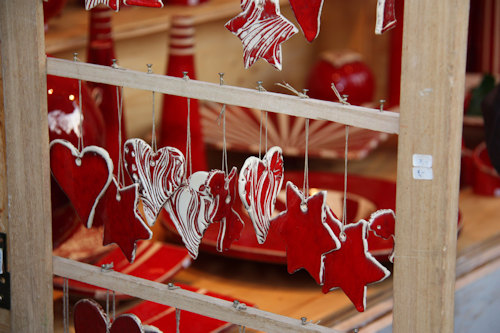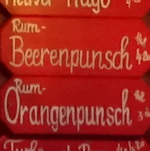Tourism in Vienna has long gone international: museums and other institutions have added English (and often other languages) to their displays and audioguides. But the Christmas markets remain traditionally Viennese.
While you find English appearing ever more often on signs and menu displays, German still dominates.
So if you wish to avoid any nasty surprises, keep your dictionary or smartphone to hand. The following explanations of common terms should help, too…
- Book a concert experience* for your Vienna trip
- See also:
One market, several words

(The Altwiener Christkindlmarkt on the Freyung)
The fun begins with the words used to mean one of the Christmas markets. The German for Christmas is Weihnachten and the word for market is Markt. So a Weihnachtsmarkt is a Christmas market.
But other terms might make an appearance, too. Christkindlmarkt, for example. Though, in Vienna, some people use this to refer specifically to the city’s most popular market on the Rathausplatz square.
(The Christkind, Christkindl or Christ child does Santa’s job in Austria: the traditional bringer of presents for children.)
You might also come across two other terms for Christmas market, but both still refer to the same concept: Weihnachtsdorf (literally “Christmas village”) or Adventmarkt (I’ll let you work that one out).
A little later in the year, you see references to a Neujahrsmarkt or Silvestermarkt (both mean New Year market).
Key market delights
Certain elements appear on stalls across all markets, beginning with:
Punsch, Häferl, and Getränke

(Many stands sell hot Christmas beverages)
Getränke are drinks, and the mainstay of any Christmas market in Vienna is the Punschstand (punch booth), which serves piping hot Weihnachtspunsch (Christmas punch).
The precise contents of this alcoholic hot beverage remain a mystery to me. (I fully intend to research the issue in more depth.)
A couple of important variations are:
- Kinderpunsch (children’s punch): punch that contains no alcohol, which may also be described as alkoholfrei (alcohol free).
- Glühwein (similar to the British concept of mulled wine). Look for Uhudlerglühwein (my preference), made from a special regional wine variety.
Boards above and around the Punschstand list the various varieties for sale.
As with most aspects of modern life, we’re no longer content with a handful of basic options; the market air carries the aroma of dozens of punch varieties, mostly based around some kind of fruit (Obst) or berries (Beeren). Common examples are:
- Apfelpunsch: apple
- Beerenpunsch: a mix of berries
- Erdbeerpunsch: strawberry
- Himbeerpunsch: raspberry
- Orangenpunsch: no prizes for guessing
Your punch comes in a Häferl (mug) and you may have to pay an Einsatz (returnable deposit). The mugs often serve as collectible souvenirs: simply abandon your deposit and keep the mug or buy one from a suitable stand.
Other alcoholic drinks available might include Bier (beer), Wein (wine), Likör and Schnaps (liquor and schnapps), and Sekt (sparkling wine).

(Häferl for punch)
For the sake of completion, words for those non-alcoholic drinks not taking a brand name (like Pepsi) include:
- Kaffee (coffee) in its various manifestations. See this glossary. Many market now have standalone mobile coffee stations
- Saft (juice) with your fruits and berries as above as prefixes. So Orangensaft is orange juice. Apfelsaft is apple juice. Often available as a fizzy gespritzt version (juice with added soda water or similar)
- Tee (tea), which is mainly fruit and herbal tea in Austria, identified through the prefix. So Kamillentee is chamomile tea, Pfefferminztee is peppermint tea, Früchtetee is a general fruit tea. Brit-style tea is Schwarztee (literally black tea and often taken without milk – blasphemy!)
- Wasser (water) with mineral water as Mineralwasser: either still (bubble free) or prickelnd (fizzy)
Food

(Lebkuchen in various shapes and sizes)
If you need to experience the sugary snack side of life, then the markets offer many such opportunities. Traditional market treats include:
- Baumkuchen: a special batter baked on a spit to form a series of rings
- Bratapfel: toffee apple
- Brezel: pretzels, though normally sold in a number of soft varieties
- Buchtel: a kind of sweet roll
- Gebrannte Nüsse: roasted and caramelised nuts with Mandel (almonds) the most popular option
- Krapfen: jam doughnuts (usually features either apricot jam or a nougat filling)
- Lebkuchen: a gingerbread-like food that also comes in bullet-proof forms
- Schaumrolle: a cream puffed pastry, with the emphasis very much on the cream-like filling
- Schokofrüchte: a skewer of fruit coated in chocolate
- Zuckerwatte: candy floss
Special mention goes to the Maronistand: a small standalone stand featuring an oven that sells Maroni (roast chestnuts) but usually also potato snacks like Wedges (um, wedges), Bratkartoffel (baked potato slices), Kartoffelpuffer (potato fritters?), and Spiralkartoffel (tornado crisps/fries).

(Roast chestnuts are known as Maroni)
You should also find some stalls selling “proper” food. The possibilities are endless, so I shall simply point you to the articles on Viennese main courses, sausages (always popular at Christmas markets), and pastries and desserts.
Expect to see plenty of Leberkäse (like meatloaf), too, often with varieties that rarely see the light of day, such as Wildschwein (wild boar) Leberkäse.
Another popular dish at the markets in recent years has been Suppe in Brot or Suppe in Brotlaibchen (soup served in a hollowed-out small loaf of bread). And yet another dish largely exclusive to markets is Ofenkartoffel (baked potatoes) with various fillings.
Finally, you might get open dark bread sandwiches featuring various toppings, but particularly Speckbrot (bread with cured ham) served with Kren (horse radish).
Some of the food is not intended for immediate consumption but for taking home or using as gifts. Look, especially, for prettily-designed jars and bottles of Honig (honey), Marmelade (careful – not marmelade but jam), Senf (mustard), Essig (vinegar), and Schnaps and Edelbrände (schnapps and refined spirits).
Arts and Crafts

(Many market stalls sell decorations, art & crafts)
Each market also sells the work of artists and artisans. Most of these should be handgemacht or handgefertigt (made by hand). This is where you pick up your Weihnachtsdekorationen (Christmas decorations) and Baumbehang or Baumschmuck (decorations for hanging on the tree).
Every market should at least also offer:
- Kerzen: candles
- Krippenfiguren: wooden figurines and other items that form part of a nativity scene
- Schneekugel: snow globes (which, incidentally, were invented in Vienna)
As far as materials go:
- Glass: glas
- Holz: wood, often with the tree as a prefix (Zirbe is Swiss pine, Olivenbaum is olive tree)
- Papier: paper
- Wolle: wool
- Zinn: tin
Now that you’re armed with the vocabulary, discover which markets are best for your particular needs.
